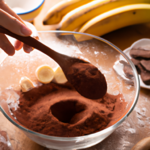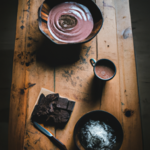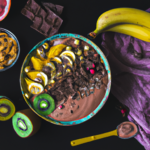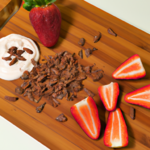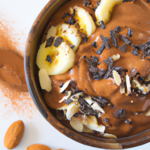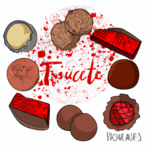Raw Food Ingredients
How To Eat Raw Cacao Powder
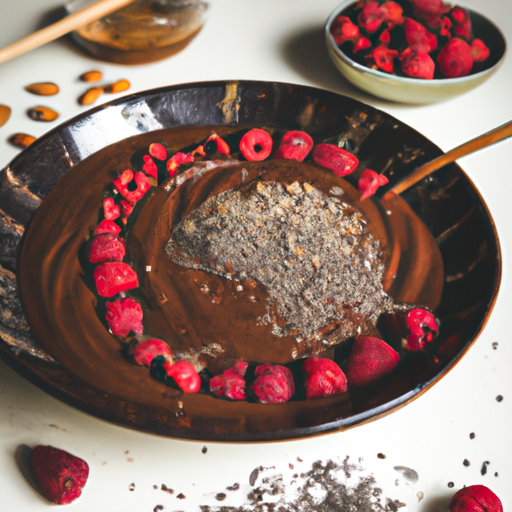
Looking for ways to add raw cacao powder to your diet? You’re in luck! In this article, I’ll show you the top ways to reap the health benefits of this tasty and nutrient-packed ingredient.
Raw cacao powder is a powerhouse of antioxidants, essential minerals, and mood-enhancing compounds. It’s a healthier alternative to processed chocolate, and there are so many creative ways to use it in your everyday meals and snacks.
From smoothies and drinks to breakfast recipes and even savory dishes, the possibilities are endless. Whether you’re a chocolate lover or simply looking to boost your overall well-being, raw cacao powder is a fantastic addition to your pantry.
So, let’s dive in and discover the wonderful world of raw cacao powder together!
Key Takeaways
- Raw cacao powder is a healthier alternative to processed chocolate, rich in antioxidants, essential minerals, and mood-enhancing compounds.
- It can be used in a variety of recipes, such as coffee or hot chocolate, homemade ice cream, brownies, cookies, cakes, and more, to enhance flavor and provide nutritional benefits.
- Raw cacao powder can be incorporated into breakfast recipes like oatmeal, yogurt, pancakes, and waffles for a decadent twist.
- It can also be used in skincare routines to nourish and rejuvenate the skin, by mixing it with honey, yogurt, or avocado for a rejuvenating face mask.
Health Benefits of Raw Cacao Powder
One of the most compelling reasons to incorporate raw cacao powder into your diet is its plethora of health benefits.
Not only does it have a rich and indulgent taste, but it also offers numerous advantages for your overall well-being.
Research has shown that raw cacao powder is packed with antioxidants, which can help improve cardiovascular health and reduce the risk of heart disease.
Additionally, it has been linked to mental health benefits, such as reducing stress and enhancing mood.
Moreover, raw cacao powder can be used in skincare routines to nourish and rejuvenate the skin.
Understanding the difference between raw cacao and processed chocolate is essential in order to fully harness its benefits.
By incorporating raw cacao powder into your daily routine, you can enjoy its many advantages while satisfying your chocolate cravings.
Understanding Raw Cacao vs. Processed Chocolate
Discover the distinctive flavors and health benefits of unprocessed cacao beans compared to traditional chocolate. When it comes to understanding raw cacao, it’s important to differentiate it from processed chocolate. Here are three key points to consider:
-
Nutritional Value: Raw cacao powder is packed with antioxidants, minerals, and vitamins, making it a powerhouse of nutrients that can support overall health and well-being.
-
Minimal Processing: Unlike processed chocolate, raw cacao powder undergoes minimal processing, which helps retain its natural nutrients and flavors.
-
Pure and Bitter Taste: Raw cacao powder has a pure and intense flavor that is slightly bitter, allowing you to experience the true essence of cacao.
By understanding the health benefits and differences between raw cacao and processed chocolate, you can make informed choices when incorporating raw cacao powder into your smoothies and drinks.
Incorporating Raw Cacao Powder into Smoothies and Drinks
Enhance the flavor and boost the nutritional value of your favorite smoothies and drinks by adding some of this nutrient-rich, unprocessed cacao goodness.
Incorporating raw cacao powder into hot beverages is a simple way to elevate your drink game. Just sprinkle a teaspoon or two into your coffee or hot chocolate and stir well. The rich, chocolatey taste of the cacao powder adds depth and complexity to your drink, while also providing a dose of antioxidants and minerals.
Another delicious way to use raw cacao powder is in homemade ice cream. Simply blend frozen bananas, a splash of almond milk, and a tablespoon of cacao powder until smooth and creamy. It’s a healthier alternative to traditional ice cream, packed with flavor and nutrition.
Now, let’s move on to baking with raw cacao powder.
Baking with Raw Cacao Powder
I absolutely love baking with raw cacao powder. It adds a rich, decadent flavor to my treats while providing a healthy boost of antioxidants and nutrients.
One of my go-to recipes is for healthy and indulgent raw cacao brownies. They are fudgy and delicious without any guilt.
I also enjoy incorporating raw cacao powder into cookies and cakes. It adds a deep chocolatey taste that can’t be beat.
Lastly, raw cacao powder makes for a fantastic topping or ingredient in desserts like ice cream, yogurt, or even smoothie bowls. It gives them that extra touch of chocolaty goodness.
Healthy and Decadent Raw Cacao Brownies
To make healthy and decadent raw cacao brownies, start by combining mashed bananas, dates, and raw cacao powder for a naturally sweet and rich flavor. For added complexity, mix in chopped walnuts or a swirl of almond butter to create a delightful nutty texture.
- Use mashed bananas and dates as natural sweeteners
- Add raw cacao powder for a rich flavor
- Incorporate chopped walnuts for a nutty texture
- Swirl in almond butter for added complexity
- Experiment with different combinations to find your favorite variation.
Raw cacao powder is a versatile ingredient that can be used in various recipes. Not only does it add depth of flavor to brownies, but it can also be used in other desserts like ice cream or protein shakes.
In the next section, we will explore how raw cacao powder can be incorporated into cookies and cakes to elevate their taste and nutritional profile.
Raw Cacao Powder in Cookies and Cakes
After enjoying the healthy and decadent raw cacao brownies, I have discovered that raw cacao powder can be used in a variety of other desserts as well. One of my favorite ways to incorporate this nutritious ingredient is by adding it to cookies and cakes. The rich and intense flavor of raw cacao powder gives these treats a delightful twist. To give you an idea of the possibilities, imagine biting into a soft and chewy chocolate chip cookie with bursts of cacao goodness in every bite. Or picture a moist and fudgy chocolate cake that melts in your mouth, leaving you craving for more. You can also experiment with using raw cacao powder in ice cream or protein bars for a guilt-free indulgence. With so many options, the versatility of raw cacao powder truly shines. Now, let’s explore how it can be used as a topping or ingredient in desserts.
Raw Cacao Powder as a Topping or Ingredient in Desserts
Raw cacao powder can be used as a topping or ingredient in desserts in several ways. Here are five delicious ideas:
- Sprinkle raw cacao powder over a scoop of vanilla ice cream for a rich and chocolatey twist.
- Mix raw cacao powder into homemade chocolate sauce for a delicious drizzle over brownies or pancakes.
- Dust raw cacao powder over a slice of cheesecake for an extra layer of flavor.
- Stir raw cacao powder into whipped cream for a delightful and indulgent topping for pies or hot cocoa.
- Blend raw cacao powder into a milkshake for a creamy and chocolaty treat.
These ideas will surely satisfy your sweet tooth and add a touch of decadence to your desserts. But did you know that raw cacao powder can also be used in coffee and breakfast recipes? Let’s explore how to incorporate this healthy ingredient into your morning routine.
Raw Cacao Powder in Breakfast Recipes
I love incorporating raw cacao powder into my breakfast recipes because it adds a rich and indulgent flavor.
One of my favorite ways to enjoy it is by sprinkling it on top of my oatmeal or yogurt. The cacao powder adds a delicious chocolatey taste and provides a boost of antioxidants and nutrients.
Another great option is to include raw cacao powder in pancakes or waffles batter. It gives them a decadent twist and makes for a satisfying breakfast.
Lastly, I enjoy using raw cacao powder in homemade granola or energy bars. It adds a natural sweetness and enhances the overall taste and texture. Plus, it’s a healthy and energizing way to start my day.
Sprinkling Raw Cacao Powder on Oatmeal or Yogurt
To enhance your breakfast, try sprinkling some raw cacao powder onto your oatmeal or yogurt for a delightful and nutritious kick. Raw cacao powder is a versatile ingredient that can add depth and complexity to your morning meal. Not only does it provide a rich chocolate flavor, but it also offers a range of health benefits. By sprinkling raw cacao powder on fruit or toast, you can create a simple yet delicious treat. Additionally, incorporating raw cacao powder into overnight oats or chia pudding can elevate the taste and provide an extra boost of antioxidants. The table below summarizes some creative ways to incorporate raw cacao powder into your breakfast:
| Sprinkle on Fruit or Toast | Mix into Overnight Oats | Add to Chia Pudding |
|---|---|---|
| Enhances flavor | Adds richness | Boosts antioxidants |
| Provides a healthy twist | Increases nutritional value | Improves texture |
Now, let’s move on to exploring how to use raw cacao powder in pancakes or waffles.
Raw Cacao Powder in Pancakes or Waffles
Incorporating raw cacao powder into pancake or waffle batter creates a decadent chocolatey twist. It’s a versatile ingredient that can be used in various breakfast recipes, adding a rich and indulgent flavor. Simply mix in a tablespoon or two of raw cacao powder into the batter for pancakes or waffles. The result is a delightful chocolate-infused treat that satisfies cravings and provides a boost of antioxidants.
You can also get creative and use raw cacao powder in crepes for an extra special touch. The possibilities are endless when it comes to incorporating this superfood into your breakfast routine.
Now, let’s explore how to use raw cacao powder in homemade granola or energy bars.
Raw Cacao Powder in Homemade Granola or Energy Bars
Adding raw cacao powder to your homemade granola or energy bars infuses them with a rich, indulgent flavor that will leave you craving more. Not only does it taste amazing, but raw cacao also provides numerous health benefits.
Here are some ways to incorporate raw cacao into your granola or energy balls:
- Mix raw cacao powder with oats, nuts, and dried fruits for a delicious and nutritious granola blend.
- Add a sprinkle of raw cacao powder to your energy ball mixture to enhance the chocolatey goodness.
- Create a chocolate granola bar by combining raw cacao powder, honey, nut butter, and seeds.
- Use raw cacao nibs as a crunchy topping for your granola or energy bars.
- Make a raw cacao drizzle by melting raw cacao butter and mixing it with raw cacao powder and a sweetener.
By incorporating raw cacao into your homemade granola or energy bars, you’ll be able to enjoy a healthy and satisfying treat. Now, let’s move on to creating more raw cacao treats and snacks.
Creating Raw Cacao Treats and Snacks
I love incorporating raw cacao powder into my snacks and treats for an extra boost of energy.
One of my go-to recipes is raw cacao energy balls or bites, which are perfect for an on-the-go snack.
I also enjoy making homemade raw cacao chocolate bars, using natural sweeteners like dates or maple syrup.
Finally, I love adding raw cacao powder to trail mix or nut butter for a delicious and nutritious snack option.
Raw Cacao Energy Balls or Bites
To make these delicious raw cacao energy balls, simply combine the raw cacao powder with dates, nuts, and a touch of honey for a burst of chocolatey goodness in every bite. This nutrient-packed snack is perfect for a midday pick-me-up or a quick post-workout boost. Here’s how to whip up these tasty treats:
-
Start by blending 1 cup of pitted dates, 1/2 cup of nuts (such as almonds or walnuts), and 2 tablespoons of raw cacao powder in a food processor until a sticky dough forms.
-
Roll the dough into bite-sized balls and place them on a baking sheet lined with parchment paper.
-
Optional: Roll the energy balls in shredded coconut or raw cacao powder for an extra touch of flavor.
-
Refrigerate the energy balls for at least 30 minutes to firm up before enjoying.
Now, let’s move on to the next section about homemade raw cacao chocolate bars, where we’ll explore another delicious way to incorporate raw cacao into your diet.
Homemade Raw Cacao Chocolate Bars
Indulge in the rich, velvety goodness of homemade raw cacao chocolate bars that will transport your taste buds to a blissful chocolate paradise. Making your own chocolate bars using raw cacao powder is not only delicious but also a healthier alternative to store-bought options. With just a few simple ingredients, you can create decadent treats that are packed with antioxidants and nutrients.
To give you an idea of the possibilities, here’s a handy table showcasing three different variations of homemade raw cacao chocolate bars:
| Variation | Ingredients | Instructions |
|---|---|---|
| Classic | Raw cacao powder, coconut oil, maple syrup | 1. Melt coconut oil. 2. Mix all ingredients. 3. Pour into a mold. |
| Mint | Raw cacao powder, coconut oil, maple syrup, peppermint extract | 1. Melt coconut oil. 2. Mix all ingredients. 3. Add peppermint extract. 4. Pour into a mold. |
| Nutty | Raw cacao powder, coconut oil, maple syrup, mixed nuts | 1. Melt coconut oil. 2. Mix all ingredients. 3. Add mixed nuts. 4. Pour into a mold. |
Once you’ve mastered the art of homemade raw cacao chocolate bars, you can explore other delectable treats like homemade cacao truffles or even indulge in a warm cup of raw cacao hot chocolate. Now, let’s move on to the next section about incorporating raw cacao powder in trail mix or nut butter.
Raw Cacao Powder in Trail Mix or Nut Butter
Elevate your trail mix or nut butter with the addition of raw cacao powder. It adds a rich and chocolatey flavor while bringing numerous health benefits. Packed with antioxidants, magnesium, and iron, raw cacao powder is a superfood. Sprinkle it onto your favorite trail mix for a satisfying and energizing snack. Mix it into homemade nut butter for a creamy and indulgent spread. Don’t limit yourself to just snacks, try it in salad dressings or homemade ice cream. Now, let’s explore how raw cacao powder can enhance savory dishes.
Raw Cacao Powder in Savory Dishes
I recently discovered that raw cacao powder can be a fantastic addition to savory dishes. It adds depth and complexity to flavors. For example, adding a small amount of raw cacao powder to chili or mole sauce creates a rich and slightly bitter undertone that pairs perfectly with the spices and heat.
In addition, using raw cacao powder in BBQ or marinades adds a unique smoky flavor that enhances the overall taste of grilled meats or vegetables.
Lastly, incorporating raw cacao powder into spice rubs or seasonings elevates the flavor profile of various dishes. It provides a hint of chocolatey goodness that takes them to the next level.
Raw Cacao Powder in Chili or Mole Sauce
Enhance the rich, smoky flavors of your chili or mole sauce by incorporating raw cacao powder into the recipe.
Nestled in the heart of chili recipes, raw cacao powder adds a depth of flavor that takes your dish to the next level. Its earthy undertones complement the spices perfectly, creating a harmonious balance that is sure to please your taste buds.
Mole sauce, known for its complex flavors, becomes even more extraordinary with the addition of raw cacao powder. The deep, chocolaty notes blend seamlessly with the traditional ingredients like chilies, nuts, and spices, creating a sauce that is both comforting and sophisticated.
As you savor each bite, the raw cacao powder adds a luxurious creaminess to your chili or mole sauce, elevating it to a gourmet delight.
Now, let’s explore the wonders of raw cacao powder in BBQ or marinades.
Raw Cacao Powder in BBQ or Marinades
Infuse your BBQ or marinades with the enchanting essence of raw cacao, and experience a symphony of flavors that will transport your taste buds to a realm of unparalleled culinary delight. Raw cacao powder adds depth and richness to your favorite BBQ sauce recipes and marinade ideas. Not only does it impart a subtle chocolatey flavor, but it also enhances the overall complexity of the dish. To showcase the versatility of raw cacao powder in BBQ and marinades, here’s a table highlighting three mouthwatering recipes:
| Recipe | Ingredients | Instructions |
|---|---|---|
| Cocoa-Rubbed Ribs | Raw cacao powder, paprika, cayenne | Rub the mixture on the ribs and grill to perfection. |
| Chocolate Marinade | Raw cacao powder, soy sauce, garlic | Marinate your meat for at least 2 hours before grilling. |
| Mole BBQ Sauce | Raw cacao powder, tomatoes, spices | Simmer the ingredients together for a delectable sauce. |
With these recipes, you can elevate your BBQ and marinades to new heights of flavor. Transitioning into the next section about raw cacao powder in spice rubs or seasonings, you’ll discover even more ways to incorporate this magical ingredient into your culinary repertoire.
Raw Cacao Powder in Spice Rubs or Seasonings
Transform your spice rubs or seasonings into a sublime culinary experience with the irresistible allure of raw cacao powder. Adding this unique ingredient to your spice rub recipes can elevate the flavors of your dishes to a whole new level.
Here are three seasoning ideas that showcase the versatility of raw cacao powder:
-
Smoky Chocolate Rub: Combine raw cacao powder with smoked paprika, garlic powder, and sea salt for a rich and smoky flavor profile. This rub is perfect for grilled meats like steak or ribs.
-
Spiced Hot Cocoa Seasoning: Mix raw cacao powder with cinnamon, nutmeg, and a touch of cayenne pepper for a warming and indulgent twist on hot cocoa. Sprinkle it over your favorite desserts or add it to your morning coffee for a spicy kick.
-
Mexican-Inspired Chili Seasoning: Blend raw cacao powder with chili powder, cumin, and oregano to create a complex and earthy spice blend. Use it to season your chili con carne or as a dry rub for roasted vegetables.
By experimenting with these spice rubs and seasonings, you’ll discover the incredible depth of flavor that raw cacao powder can bring to your dishes.
Now, let’s explore other uses for this versatile ingredient.
Exploring Other Uses for Raw Cacao Powder
There are so many creative ways to incorporate raw cacao powder into your daily routine! Not only is it delicious in recipes, but it can also be used in skincare routines. Raw cacao powder is rich in antioxidants, which can help nourish and protect your skin. One way to explore its benefits is by incorporating it into homemade face masks. Mixing raw cacao powder with ingredients like honey, yogurt, or avocado can create a luxurious and rejuvenating mask that will leave your skin feeling refreshed and glowing.
To help you enjoy the information provided, here’s a table showcasing a few homemade face mask recipes using raw cacao powder:
| Recipe | Ingredients |
|---|---|
| Hydrating Mask | Raw cacao powder, honey, avocado |
| Exfoliating Mask | Raw cacao powder, coffee grounds, yogurt |
| Antioxidant Mask | Raw cacao powder, green tea, aloe vera |
| Brightening Mask | Raw cacao powder, turmeric, lemon juice |
| Soothing Mask | Raw cacao powder, oatmeal, chamomile tea |
By exploring raw cacao powder in skincare, you can enhance your beauty routine naturally. Now, let’s move on to the next section about tips for storing and buying raw cacao powder.
Tips for Storing and Buying Raw Cacao Powder
To make sure you’re getting the best quality and longest shelf life for your cacao powder, here are some helpful tips for storing and purchasing it.
When it comes to storing techniques, it’s important to keep your raw cacao powder in an airtight container in a cool, dark place. This will help preserve its flavor and prevent any moisture from seeping in. Avoid storing it in the refrigerator, as the moisture and odors can affect the taste.
As for purchasing considerations, look for raw cacao powder that is organic and fair trade certified. This ensures that it is of high quality and has been produced in an environmentally and socially responsible manner. Additionally, check the expiration date to ensure freshness.
By following these tips, you can enjoy the full benefits of your raw cacao powder for a longer period of time.
Frequently Asked Questions
Can raw cacao powder be used as a replacement for cocoa powder in baking recipes?
Yes, raw cacao powder can be used as a replacement for cocoa powder in baking recipes. It has a richer flavor and more health benefits, such as high antioxidants and minerals.
Is raw cacao powder suitable for people with lactose intolerance?
Raw cacao powder is a great option for those with lactose intolerance. It offers numerous health benefits for individuals who struggle with lactose, providing a delicious and nutritious alternative to traditional cocoa powder in recipes.
Can raw cacao powder be added to coffee or tea for flavor?
Yes, raw cacao powder can be added to coffee or tea for added flavor. It not only enhances the taste, but also provides numerous health benefits, such as antioxidants and mood-boosting properties.
How much raw cacao powder should be consumed daily for maximum health benefits?
To maximize health benefits, it’s recommended to consume up to 1-2 tablespoons of raw cacao powder daily. Regular intake has been linked to improved heart health, increased brain function, and enhanced mood.
Is it safe to consume raw cacao powder during pregnancy?
During pregnancy, it is generally safe to consume raw cacao powder in moderate amounts. However, it’s important to monitor your blood pressure as excessive intake may increase it. Additionally, raw cacao powder can affect digestion, so listen to your body and adjust your intake accordingly.
Is it Safe to Consume Raw Cacao Powder While Fasting?
Yes, consuming raw cacao powder while fasting is generally safe. However, it’s essential to be mindful of the added sugar or fats often present in commercial cacao products. Also, be cautious when drinking coffee during fasting restrictions, as it may trigger an insulin response, potentially breaking the fast.
Conclusion
To wrap it up, raw cacao powder is truly a superfood that can add a delicious and healthy twist to your meals and snacks. Whether you’re blending it into a smoothie, baking it into treats, or even adding it to savory dishes, the possibilities are endless.
Not only does raw cacao powder provide numerous health benefits, but it also satisfies your chocolate cravings in a guilt-free way. So go ahead, get creative in the kitchen, and enjoy the rich and indulgent flavors that raw cacao powder has to offer.
It’s time to indulge in some chocolatey goodness!
Rachael, the Editor in Chief of RachaelsRawFood.com, is an inspiring and passionate individual who has dedicated her life to promoting the benefits of a raw food lifestyle. Known for her vibrant and energetic personality, Rachael has built a strong online presence that has transformed her personal journey into a thriving community of raw food enthusiasts.
Raw Food Ingredients
How Much Caffeine in Cocoa?
Not all cocoa products are created equal when it comes to caffeine content – discover which one might surprise you!
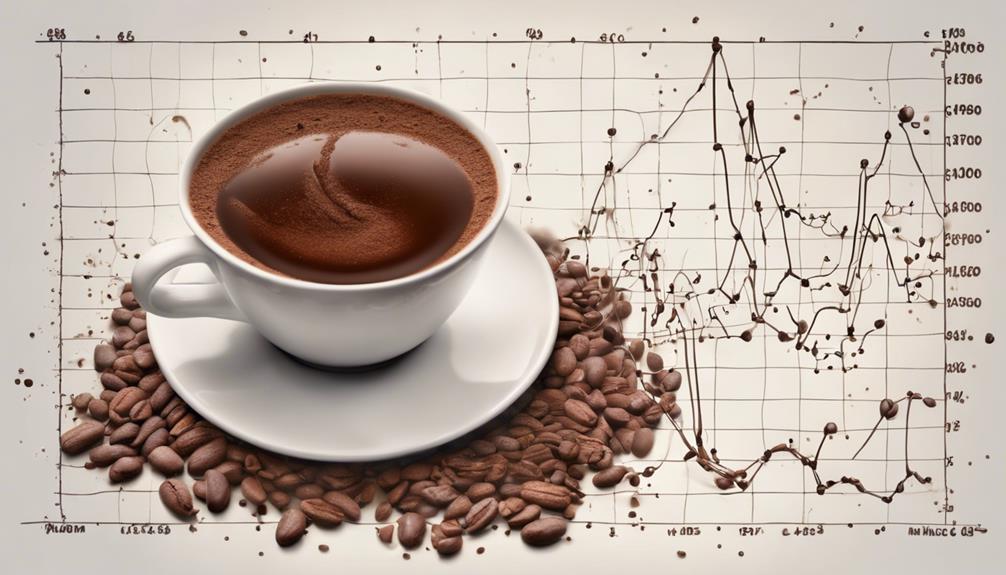
When evaluating the caffeine levels in cocoa, it’s important to recognize that dark chocolate contains around 43 mg of caffeine per 100 grams due to its high cocoa solid content. Dark chocolate has a higher caffeine content compared to milk or white chocolate. This means that consuming dark chocolate in moderation can assist in managing your caffeine intake. On the other hand, milk chocolate has around 20 mg of caffeine per 100 grams while white chocolate is caffeine-free. Cocoa powder, commonly used in baking and beverages, contains a substantial 230 mg of caffeine per 100 grams. Being aware of these distinctions in chocolates can help you make informed decisions about your caffeine consumption.
Key Takeaways
- Caffeine content in cocoa varies based on cocoa solid concentrations.
- Unsweetened cocoa powder can contain around 230 mg of caffeine per 100 grams.
- Roasting cocoa solids influences the final caffeine content in cocoa products.
- Dark chocolate, with high cocoa solid content, has more caffeine than milk chocolate.
- Moderate consumption of cocoa products helps manage caffeine intake.
Caffeine Content in Dark Chocolate
Dark chocolate boasts a caffeine content of approximately 43 mg per 100 grams, mainly deriving from its higher cocoa solid composition. When we indulge in this decadent treat, we aren't only savoring its rich cocoa flavor but also a subtle caffeine kick. Compared to milk or white chocolate, dark chocolate contains a higher amount of caffeine.
Please bear in mind that moderate consumption of dark chocolate can assist individuals in managing their caffeine intake effectively. The caffeine levels in dark chocolate are about one-fourth of what you'd find in a standard cup of coffee. So, if you're looking for a milder caffeine boost, a piece of dark chocolate might just do the trick without the jitters that sometimes accompany a strong cup of coffee.
Enjoy your dark chocolate in moderation, savoring both its taste and the gentle pick-me-up it provides.
Caffeine Levels in Milk Chocolate
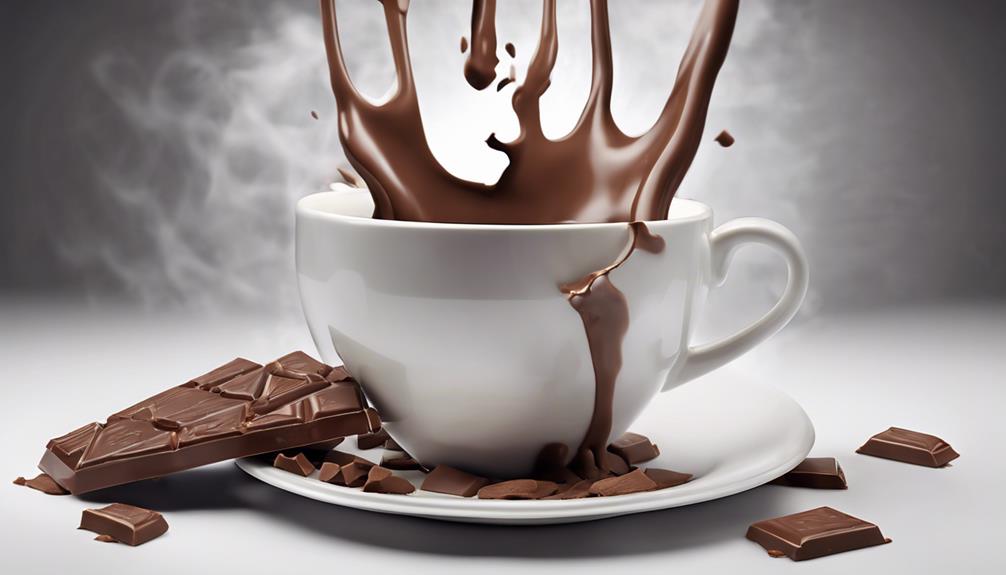
Milk chocolate, known for its creamy texture and sweet flavor, contains a modest caffeine content of approximately 5.6 mg per ounce, as indicated by USDA data. Unlike dark chocolate, milk chocolate has a lighter color due to lower cocoa content, resulting in reduced caffeine levels.
The delightful creamy taste in milk chocolate comes from a harmonious blend of cocoa and milk powder. While dark chocolate boasts higher caffeine content, milk chocolate remains a popular choice for those seeking a sweet treat with minimal caffeine intake.
Caffeine Presence in White Chocolate
With its unique composition excluding cocoa solids, white chocolate stands out as a caffeine-free alternative to its darker counterparts. White chocolate is crafted from a blend of cocoa butter, milk powder, sugar, and vanilla, making it a delectable treat without the stimulating effects of caffeine. For individuals sensitive to caffeine, white chocolate offers a creamy texture and indulgent flavor without the worry of unwanted side effects. This makes it a popular choice for desserts among those looking to steer clear of caffeine in their sweet treats.
Compared to dark chocolate, which contains cocoa solids and hence caffeine, white chocolate provides a caffeine-free option for those seeking a more mellow indulgence. So, if you're in the mood for a luscious and smooth chocolate experience without the buzz of caffeine, white chocolate is the perfect choice for your next dessert delight.
Impact of Cocoa Solids on Caffeine
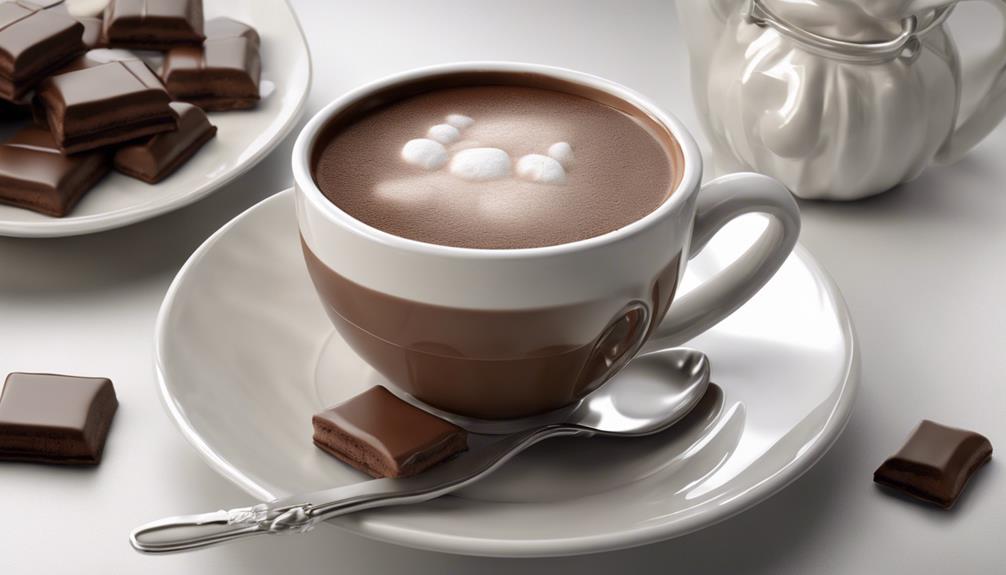
In determining the caffeine levels in cocoa products, the percentage of cocoa solids plays a significant role. Here are some key points about the impact of cocoa solids on caffeine content:
- Caffeine Derivation: The caffeine content in cocoa primarily comes from cocoa solids, making it an important factor in determining the overall caffeine levels in cocoa-based products.
- Dark Chocolate: Dark chocolate, known for its higher cocoa solid content, tends to contain more caffeine compared to milk or white chocolate varieties due to this higher concentration.
- Unsweetened Cocoa Powder: A 100g serving of unsweetened cocoa powder can contain around 230mg of caffeine, reflecting the impact of the high cocoa solid content in this form.
- Health Benefits: The roasting process of cocoa solids not only affects the flavor profile but also influences the caffeine content, contributing to the potential health benefits associated with consuming cocoa products like hot cocoa.
Comparing Caffeine in Different Chocolates
Comparing the caffeine content in different chocolates reveals varying levels based on their cocoa solid concentrations. Dark chocolate contains about 43 mg of caffeine per 100 grams, making it a stronger caffeinated option compared to milk chocolate, which only has around 20 mg per 100 grams.
Surprisingly, white chocolate, derived from cocoa butter, doesn't contain any caffeine at all. For those seeking a more potent caffeine kick, cocoa powder is the way to go, boasting a high concentration of 230 mg per 100 grams.
The amount of caffeine in chocolate products is closely linked to the cocoa solid content, with dark chocolate containing the highest levels. So, the next time you're craving a chocolate treat but also need a little energy boost, opt for dark chocolate to get the most caffeine per bite.
Frequently Asked Questions
Is There More Caffeine in Cocoa Than Coffee?
There's more caffeine in cocoa than in coffee. Cocoa powder packs 230 mg per 100 grams, surpassing most coffee varieties. Dark chocolate has even more caffeine due to higher cocoa content. It's a rich, unique energy source.
Is There a Lot of Caffeine in Hot Cocoa?
There isn't a lot of caffeine in hot cocoa. It depends on the brand and recipe. Starbucks hot chocolate has around 25 mg per serving, while basic mixes have about 5 mg. The amount of cocoa powder used influences the caffeine content.
Is There Caffeine in Hershey's Cocoa?
Absolutely, Hershey's Cocoa does contain caffeine, but it's not overwhelming. It adds a delightful hint of energy in each spoonful. Perfect for baking or a cozy cup of hot chocolate. Just the right amount!
Is Cocoa a Stimulant Like Caffeine?
Cocoa stimulates like caffeine due to its theobromine content. Decaf versions offer a solution for caffeine-sensitive folks. Options include regular cocoa with caffeine, Dutch-processed cocoa with less, and decaf cocoa with reduced caffeine while keeping healthful compounds.
What are the potential health effects of consuming high levels of caffeine in cocoa?
Unveiling cocoa caffeine levels can lead to potential health effects of excessive consumption. High levels of caffeine in cocoa may contribute to insomnia, nervousness, and fast heartbeat. It can also cause gastrointestinal discomfort and exacerbate anxiety disorders. Moderation in consuming caffeinated cocoa products is recommended for overall health.
Conclusion
To sum up, the caffeine content in cocoa varies depending on the type of chocolate. Dark chocolate typically has the highest caffeine levels, followed by milk chocolate and white chocolate. The amount of cocoa solids in the chocolate also affects the caffeine content.
Remember, just like different chocolates have different levels of caffeine, we all have unique strengths and abilities. Embrace your individuality and always aim for balance in everything you do.
Rachael, the Editor in Chief of RachaelsRawFood.com, is an inspiring and passionate individual who has dedicated her life to promoting the benefits of a raw food lifestyle. Known for her vibrant and energetic personality, Rachael has built a strong online presence that has transformed her personal journey into a thriving community of raw food enthusiasts.
Raw Food Ingredients
5 Key Differences: Caffeine Content in Cocoa Vs Coffee
Open the door to understanding the contrasting caffeine levels in cocoa and coffee, revealing surprising insights that will reshape your beverage choices.
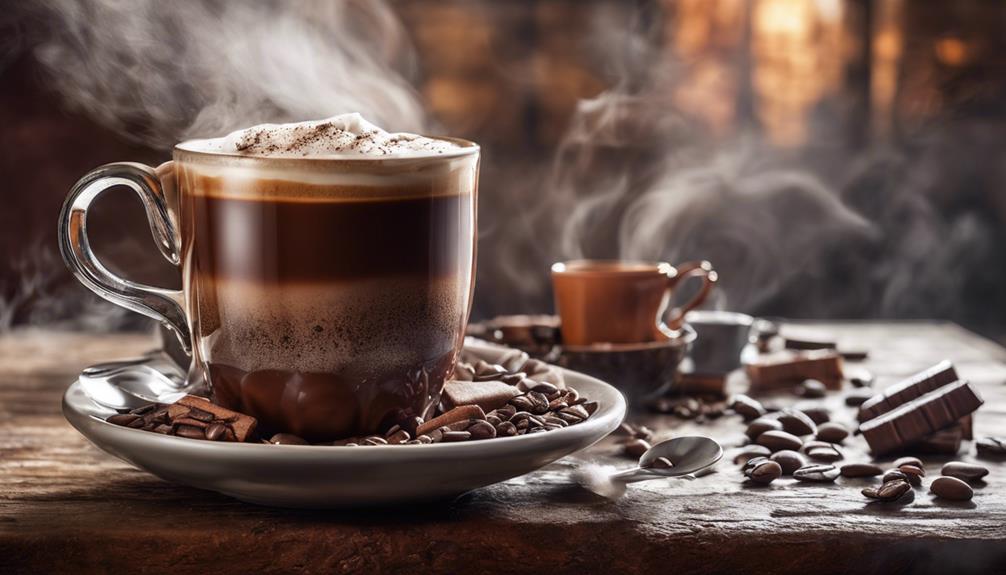
When comparing the caffeine levels in cocoa and coffee, it is important to understand that cocoa generally has lower caffeine content than coffee. Dark chocolate contains approximately 12 milligrams of caffeine per ounce, while hot cocoa typically ranges from 5 to 10 milligrams per ounce. In contrast, brewed coffee can have significantly higher levels, varying from 95 to 165 milligrams per 8-ounce cup.
Cocoa is considered a milder option for individuals aiming to limit their caffeine intake, with theobromine providing a gradual energy increase. Meanwhile, coffee's caffeine content offers immediate alertness, and understanding these distinctions can help you select based on your preferred effects.
Key Takeaways
- Cocoa contains lower caffeine levels but compensates with theobromine for a gradual energy increase.
- Coffee has higher caffeine content, offering an immediate alertness boost and potentially higher metabolic rate.
- Theobromine in cocoa promotes relaxation, while caffeine in coffee provides intense alertness and mood fluctuations.
- Hot chocolate is a good option for reducing caffeine intake while still benefiting from theobromine effects.
- Understanding caffeine variances helps make informed choices for desired energy levels and mood effects.
Caffeine Levels in Cocoa Vs Coffee
When comparing caffeine levels in cocoa versus coffee, it's evident that cocoa generally contains lower amounts per serving. Dark chocolate, made from cacao beans, contains around 12 milligrams of caffeine per ounce, while a 1-ounce serving of hot cocoa mix typically has 5-10 milligrams. Even a 16-ounce serving of Starbucks hot chocolate only contains about 25 milligrams of caffeine.
On the other hand, coffee, when brewed, can range from 95 to 165 milligrams of caffeine per 8-ounce cup, depending on the type and brewing method. This significant difference in caffeine content between cocoa and coffee makes cocoa a milder option for those looking to limit their caffeine intake.
Impact on Alertness and Energy
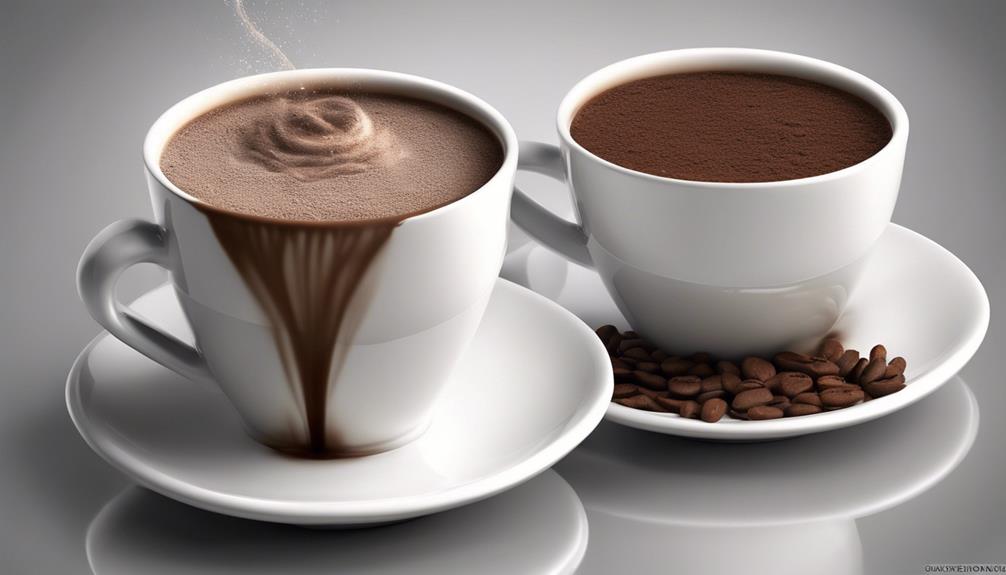
Typically, the immediate alertness and energy boost from caffeine in coffee can last for hours. This surge in alertness is due to caffeine's stimulating effect on the central nervous system. On the other hand, cocoa contains theobromine, which provides a more gradual increase in energy levels. Unlike caffeine, theobromine doesn't cause sudden spikes and crashes, offering a smoother energy curve.
Coffee's caffeine content can temporarily boost the metabolic rate, potentially supporting weight management efforts. This increased metabolic rate can aid in burning calories and may contribute to weight loss when combined with a balanced diet and regular exercise. Additionally, theobromine in cocoa contributes to the thermogenic effect, leading to mild calorie burning in the body.
Both caffeine and theobromine can influence mood. Caffeine tends to provide a more intense and quick-acting mood elevation, while theobromine promotes feelings of relaxation and contentment. Understanding the differences in alertness, energy, metabolic effects, and mood enhancements between cocoa and coffee can help individuals make informed choices based on their preferences and wellness goals.
Metabolic Variances and Effects
Regarding metabolic variances and effects, the varying caffeine levels between cocoa and coffee play a significant role. When comparing the metabolic impact of caffeine in cocoa and coffee, it is crucial to note that cocoa contains lower levels of caffeine but compensates with theobromine, which aids in the thermogenic effect, promoting calorie burning and metabolic activity. On the other hand, coffee, especially brewed varieties, contains higher levels of caffeine, potentially providing a temporary boost to the metabolic rate, which could assist in weight management. While caffeine in coffee offers a quick energy surge, theobromine in cocoa leads to a more gradual rise in energy levels, avoiding sudden spikes and crashes. To summarize the metabolic differences, I've created a table below:
| Aspect | Cocoa | Coffee |
|---|---|---|
| Caffeine Content | Lower levels | Higher levels |
| Additional Component | Theobromine | Caffeine |
| Metabolic Impact | Thermogenic effect | Temporary metabolic rate boost |
| Energy Levels | Gradual rise | Quick surge |
| Weight Management | Aids in calorie burning | Potential assistance |
Mood Enhancement Disparities

In comparing the mood enhancement effects of theobromine in cocoa and caffeine in coffee, notable disparities emerge in their impact on mental well-being.
The theobromine found in cocoa promotes relaxation and contentment, offering a gradual rise in energy levels that leads to a gentle and long-lasting mood enhancement experience.
On the other hand, caffeine delivers an intense and fast-acting boost in alertness, providing immediate energy levels that can lead to abrupt spikes and crashes.
While both theobromine and caffeine uplift mood, theobromine's effects are characterized by a steady and gradual increase in energy levels, creating a sense of calm and contentment.
In contrast, caffeine's impact is more intense and temporary, resulting in rapid alertness but also the potential for fluctuations in mood. Understanding these differences can help individuals choose between cocoa and coffee based on their desired mood enhancement effects.
Health Implications and Considerations
Health implications and considerations surrounding caffeine consumption warrant close attention due to its potential impact on various aspects of well-being. When comparing a cup of coffee to hot chocolate, it's vital to note the amount of caffeine present.
While coffee contains much caffeine, hot chocolate has less caffeine but isn't entirely devoid of it. The main active ingredients in hot chocolate are theobromine and caffeine, where theobromine is a relative of caffeine and also has stimulant effects, although milder. If you're looking to reduce your caffeine intake, opting for hot chocolate over a cup of coffee can be a good choice.
Being mindful of the caffeine content in chocolate products is important, especially if you're sensitive to caffeine or belong to vulnerable populations like children or pregnant women. Understanding the caffeine levels in different beverages allows you to make informed decisions about your consumption for better overall health.
Frequently Asked Questions
Is There Caffeine in Coffee Vs Cacao Powder?
Yes, there is caffeine in coffee, with around 140 milligrams in a 12-ounce cup. On the other hand, cacao powder contains only about 12 milligrams per tablespoon, making it a great caffeine-free alternative for those seeking a milder boost.
What Is the Difference Between Cocoa and Coffee?
When comparing cocoa and coffee, cocoa offers a rich, chocolatey flavor and is packed with antioxidants and minerals. Coffee, on the other hand, provides a robust, bitter taste and a jolt of caffeine for that morning pick-me-up.
Why Is Cocoa Better Than Coffee?
I believe cocoa is superior to coffee because it offers a gentler energy boost, promotes relaxation and contentment, and provides sustained vitality without sudden crashes. Plus, dark chocolate's theobromine supports cellular health and tastes delicious.
How Much Caffeine Is in Cocoa Powder Vs Decaf Coffee?
In cocoa powder vs decaf coffee, cocoa has 12-26mg of caffeine per tbsp, while decaf coffee holds 2-5mg per 8-ounce cup. The choice hinges on desired caffeine levels and flavor. I prefer cocoa's lower caffeine content.
How does the caffeine content in hot chocolate compare to coffee?
Hot chocolate caffeine content is significantly lower than that of coffee. While an 8-ounce cup of hot chocolate contains about 5-10 milligrams of caffeine, the same size of coffee can have anywhere from 95-200 milligrams. It’s a notable difference for those looking to limit their caffeine intake.
Conclusion
To sum up, while cocoa and coffee both contain caffeine, the levels vary significantly. Cocoa generally has lower caffeine content compared to coffee, impacting alertness, energy levels, and mood enhancement differently.
It's crucial to keep these differences in mind when choosing between the two beverages for your daily consumption. Remember, moderation is key to maintaining a healthy balance in your caffeine intake.
So, whether you prefer a cup of cocoa or a mug of coffee, enjoy it in moderation for the best benefits!
Rachael, the Editor in Chief of RachaelsRawFood.com, is an inspiring and passionate individual who has dedicated her life to promoting the benefits of a raw food lifestyle. Known for her vibrant and energetic personality, Rachael has built a strong online presence that has transformed her personal journey into a thriving community of raw food enthusiasts.
Raw Food Ingredients
A Guide to Becoming a Good King
Kingship demands wisdom, fairness, integrity, courage, and humility – essential traits for a successful reign and prosperous kingdom." Keep reading to uncover the secrets of becoming a good king.

In order to be a good king, one must embody wisdom, fairness, integrity, courage, and humility to lead the kingdom with honor. Wisdom is essential for making important decisions, fairness ensures just treatment for all, integrity builds trust and respect, courage is crucial for facing challenges, and humility reminds us of our humanity. Historical kings such as Solomon, Arthur, David, Charlemagne, and Ramses II serve as role models for these leadership traits.
As a king, embracing challenges, understanding the world, seeking personal growth, and learning from the past are essential responsibilities. Developing leadership skills, making wise decisions, and prioritizing the well-being of the people are key to effective kingship. Every step on the path to becoming a good king is critical for a successful reign and prosperous kingdom.
Key Takeaways
- Embrace wisdom for informed decisions.
- Practice fairness for just treatment.
- Uphold integrity to earn trust.
- Show courage in facing challenges.
- Maintain humility for empathy and respect.
Qualities of a Good King
Being a good king requires embodying qualities such as wisdom, fairness, integrity, courage, humility, and compassion in decision-making and leadership. Power comes with responsibility, and as a king, it's essential to wield this power wisely. Wisdom is vital in making sound judgments that benefit the kingdom as a whole. Fairness guarantees that all subjects are treated justly and equitably, fostering a harmonious society. Integrity is the foundation of trust and respect, key elements in effective leadership.
Courage is necessary to face challenges and make difficult decisions, even when met with opposition. Humility reminds a king of his humanity and the importance of humility in interactions with all subjects. Compassion demonstrates a king's care and empathy towards his people, fostering a sense of unity and loyalty. Effective communication is crucial for conveying decisions, listening to concerns, and inspiring confidence in leadership.
Historical Kings as Role Models

King Solomon, renowned for his wisdom and leadership, stands as an exemplar among historical kings who serve as role models for future leaders. Looking at figures like King Arthur, known for his justice and valor in medieval legends, and King David, celebrated for his faith and courage in battle, we find lessons that transcend time. Charlemagne's legacy of military conquests and cultural revival, alongside Ramses II's grand building projects and military campaigns, offer diverse insights into effective kingship. Below is a table summarizing key attributes of these historical kings:
| King | Attributes |
|---|---|
| King Solomon | Wisdom, leadership |
| King Arthur | Justice, valor |
| King David | Faith, courage |
| Charlemagne | Military prowess, culture revival |
| Ramses II | Building projects, military campaigns |
Studying these historical figures can provide valuable lessons on the multifaceted qualities that make a great ruler.
Responsibilities of Kingship
Embracing challenges and living authentically are central to fulfilling the responsibilities inherent in kingship. As men aspiring to be good kings, it's essential for us to understand that the world requires leaders who are kind, humble, and committed to personal growth.
The journey to becoming a good king involves more than just wielding power and responsibility—it entails sacrificing comfort for growth and transformation. Seeking the ancient path of masculinity, as exemplified by figures like Morgan, teaches us the importance of humility, vulnerability, and character development.
In fulfilling the responsibilities of kingship, we're entrusted with power not for our own gain, but for the betterment of the world around us. Just as seeds need Good Soil to flourish, we must nurture our own growth to lead effectively.
Leadership Skills for Kings

Developing essential leadership skills is crucial for aspiring kings seeking to fulfill their responsibilities with humility, vulnerability, and a focus on character development. As you study the world around us, the power and responsibility of what kingship entails become clearer. Here are some key points to think about on your path to becoming a king:
- Embrace challenges and live authentically.
- Seek ancient paths of masculinity for guidance.
- Reflect on your identity, purpose, and ability to be entrusted with power for good.
- Sacrifice comfort for growth, transformation, and participation in universal creativity.
The journey of becoming a king isn't just about gaining authority but about understanding the remarkable fellowship of like-hearted individuals who share similar goals. Engage in group discussion questions, consider between-session personal study, and explore the depths of your masculine soul. This is the path to restoring what it means to be a true king.
Importance of Wise Decision-Making
Steering through the intricacies of leadership, especially in the domain of kingship, requires a sharp focus on the art of prudent decision-making. Wise decision-making is like the compass guiding the ship of leadership towards success.
Good kings understand that their choices impact not just themselves but also the lives of those they rule over. They prioritize the well-being of their people over personal gains, embodying the essence of true leadership.
Seeking counsel from trusted advisors and reflecting on core values are essential practices in the domain of wise decision-making. By embracing humility and self-awareness, kings can navigate the complex web of choices with clarity and integrity.
Just like a six-session video Bible study can guide individuals in restoring the heart, wise decision-making is essential for becoming the kind of leaders our world needs. Let's start on this journey of radical reconstruction, where every decision is a step towards being counted among the good kings of history.
Frequently Asked Questions
What Is the Becoming a King Guide?
The Becoming a King guide is a transformative resource created by Morgan Snyder to help men grow into responsible kings. It offers practical tools and profound insights to aid personal development and transformation.
What Are the Qualities of a Good King?
Being a good king means embodying humility, wisdom, and integrity. Prioritizing the well-being of my people, making decisions for the greater good, and showing courage, justice, and compassion in all actions. Seeking counsel and valuing diverse perspectives is essential.
What Makes a True King?
Beneath the crown lies a heart that beats with humility and a spirit that soars with honor. True kings are forged in the fires of challenge, embracing authenticity and growth to inspire others.
What Makes a Real King?
Being a true king means embodying humility, courage, and empathy. It's about serving others and leading with integrity. I endeavor to cultivate these qualities daily, embracing challenges and seeking growth in all aspects of my life.
How Can Sacred Cacao be Incorporated Into Kingship Rituals?
In kingship rituals, the sacred cacao ritual holds great significance. The ceremonial drinking of cacao symbolizes the divine connection between the ruler and the spiritual realm. It is believed to impart wisdom and strength, making it a crucial element in the coronation and leadership rites of many cultures.
Conclusion
To sum up, becoming a good king requires a combination of qualities, skills, and responsibilities. Remember, 'With great power comes great responsibility.'
By studying historical kings as role models, practicing leadership skills, and making wise decisions, one can aspire to be a just and effective ruler.
It's a challenging path, but with dedication and perseverance, anyone can endeavor to be a worthy leader for their kingdom.
Rachael, the Editor in Chief of RachaelsRawFood.com, is an inspiring and passionate individual who has dedicated her life to promoting the benefits of a raw food lifestyle. Known for her vibrant and energetic personality, Rachael has built a strong online presence that has transformed her personal journey into a thriving community of raw food enthusiasts.
-

 Raw Food Ingredients2 months ago
Raw Food Ingredients2 months agoHow To Make Hot Chocolate With Raw Cacao Powder
-

 Raw Food Ingredients2 months ago
Raw Food Ingredients2 months agoHow To Make Chocolate From Raw Cacao
-

 What is Raw Food?2 weeks ago
What is Raw Food?2 weeks agoHow To Remove Raw Mustard Oil Smell From Cooked Food
-

 Raw Food Ingredients4 weeks ago
Raw Food Ingredients4 weeks agoRaw Cacao Powder How Much For 8 Oz Hot Chocolate Recipe
-
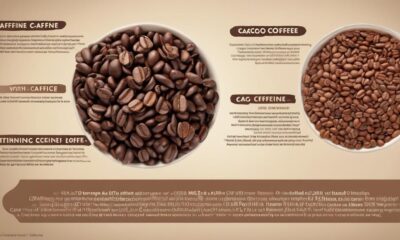
 Raw Food Ingredients4 weeks ago
Raw Food Ingredients4 weeks agoThe Truth Behind the Cacao Caffeine Myth
-
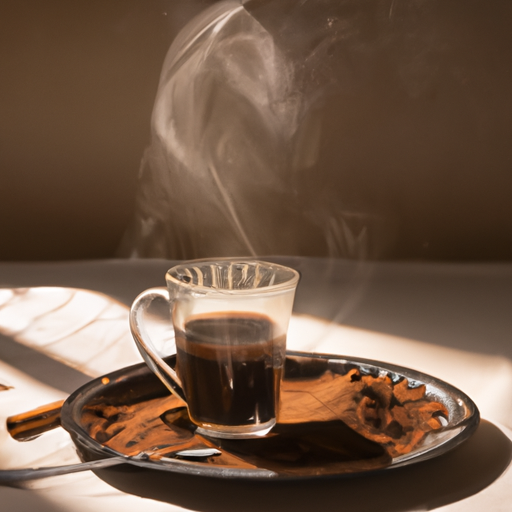
 Raw Food Ingredients2 months ago
Raw Food Ingredients2 months agoWhen Fasting Can I Drink Coffee With Raw Cacao Powder
-

 What is Raw Food?2 weeks ago
What is Raw Food?2 weeks agoHow To Store Raw And Cooked Food Separately
-

 Raw Food Ingredients2 months ago
Raw Food Ingredients2 months agoHow To Use Raw Cacao Beans




